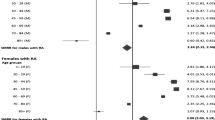Abstract
Introduction
Rheumatic heart disease is considered well-controlled in high-income countries; however, its actual trends in mortality remain unclarified. We analyzed trends in mortality from rheumatic heart disease in association with age, period, and birth cohort.
Methods
We analyzed the WHO mortality database to determine trends in mortality from rheumatic heart disease in the UK, Germany, France, Italy, Japan, Australia, USA, and Canada from 2000 to 2020. We used age-cohort-period modeling to estimate cohort and period effects. Net drift (overall annual percentage change), local drift (annual percentage change in each age group) and heterogeneity were calculated.
Results
In the most recent year, crude mortality rates and age-standardized mortality rates ranged from 1.10 in the USA to 6.17 in Germany, and 0.32 (95% CI 0.31–0.34) in Japan and 1.70 (95% CI 1.65–1.75) in Germany, respectively. During the observation period, while Germany had a constant trend in overall annual percentage change, all the other countries had significant decreasing trends (p < 0.0001, respectively). Annual percent change was not homogeneous across each group in all 8 countries (pheterogeneity < 0.0001), with 2 peaks in the younger and older age categories. In Germany, Italy, Australia, and Canada, we found increasing mortality rates among older patients. Improving period and cohort risks for rheumatic heart disease mortality were generally observed, excluding Germany where the period effect was worsening and the cohort effect was constant.
Conclusions
Mortality trends from rheumatic heart disease were decreasing in the study high-income countries except for Germany where higher mortality and two peaks in annual percentage change in younger and older age groups warrant further investigation.
Graphical Abstract





Similar content being viewed by others
Data availability
The full dataset supporting the conclusions of this article is available at WHO mortality database, https://www.who.int/data/mortality/.
Abbreviations
- APC:
-
Annual percentage change
- FDA:
-
The food and drug administration
- RHD:
-
Rheumatic heart disease
References
Kamblock J, N’Guyen L, Pagis B et al (2005) Acute severe mitral regurgitation during first attacks of rheumatic fever: clinical spectrum, mechanisms and prognostic factors. J Heart Valve Dis 14:440–446
Iung B, Vahanian A (2011) Epidemiology of valvular heart disease in the adult. Nat Rev Cardiol 8:162–172
Marijon E, Mirabel M, Celermajer DS, Jouven X (2012) Rheumatic heart disease. Lancet 379:953–964
Sliwa K, Carrington M, Mayosi BM, Zigiriadis E, Mvungi R, Stewart S (2010) Incidence and characteristics of newly diagnosed rheumatic heart disease in urban African adults: insights from the heart of Soweto study. Eur Heart J 31:719–727
Carapetis JR, Currie BJ, Mathews JD (2000) Cumulative incidence of rheumatic fever in an endemic region: a guide to the susceptibility of the population? Epidemiol Infect 124:239–244
Karthikeyan G, Guilherme L (2018) Acute rheumatic fever. Lancet 392:161–174
Kaplan EL (2005) Pathogenesis of acute rheumatic fever and rheumatic heart disease: evasive after half a century of clinical, epidemiological, and laboratory investigation. Heart 91:3–4
Sanyal SK, Thapar MK, Ahmed SH, Hooja V, Tewari P (1974) The initial attack of acute rheumatic fever during childhood in North India; a prospective study of the clinical profile. Circulation 49:7–12
Marcus RH, Sareli P, Pocock WA, Barlow JB. The spectrum of severe rheumatic mitral valve disease in a developing country. Correlations among clinical presentation, surgical pathologic findings, and hemodynamic sequelae. Ann Intern Med 1994;120:177–83.
Sampath KA (2020) Surgical options in rheumatic heart disease: an Indian surgeon’s perspective. Asian Cardiovasc Thorac Ann 28:371–373
Finucane K, Wilson N (2013) Priorities in cardiac surgery for rheumatic heart disease. Glob Heart 8:213–220
Tibazarwa KB, Volmink JA, Mayosi BM (2008) Incidence of acute rheumatic fever in the world: a systematic review of population-based studies. Heart 94:1534–1540
World Health Organization. WHO Mortality Database. Accessed March 20, 2022. https://www.who.int/data/mortality/
United Nations. Department of Economic and Social Affairs. Population Division. World Population Prospects 2019, Online Edition. Rev. 1. Accessed February 17, 2022. https://population.un.org/wpp/
Ahmad OB, Boschi-Pinto C, Lopez AD, Murray CJ, Lozano R, Inoue M. AGE STANDARDIZATION OF RATES: A NEW WHO STANDARD (GPE Discussion Paper Series: No. 31), Geneva: World Health Organization. Accessed September 20, 2021.
Tiwari RC, Clegg LX, Zou Z (2006) Efficient interval estimation for age-adjusted cancer rates. Stat Methods Med Res 15:547–569
Sasieni PD (2012) Age–period–cohort models in stata. Stand Genomic Sci 12:45–60
Rosenberg PS, Check DP, Anderson WF (2014) A web tool for age–period–cohort analysis of cancer incidence and mortality rates. Cancer Epidemiol Biomarkers Prev 23:2296–2302
United Nations High Commissioner for Refugees. Global Trends Forced Displacement In 2021. 2022.
Keyes KM, Li G. Age–Period–Cohort Modeling. 2012.
Mylotte D, Osnabrugge RLJ, Windecker S et al (2013) Transcatheter aortic valve replacement in Europe: adoption trends and factors influencing device utilization. J Am Coll Cardiol 62:210–219
Davies WR, Thomas MR (2014) European Experience and Perspectives on Transcatheter Aortic Valve Replacement. Prog Cardiovasc Dis 56:625–634
Acknowledgement
We are thankful for the data publicly made available by WHO. We are solely responsible to the analyses, interpretations, or conclusions of this publication.
Funding
None.
Author information
Authors and Affiliations
Corresponding author
Ethics declarations
Conflict of interest
The authors declare that they have no conflict of interest to this work.
Supplementary Information
Below is the link to the electronic supplementary material.
Rights and permissions
Springer Nature or its licensor (e.g. a society or other partner) holds exclusive rights to this article under a publishing agreement with the author(s) or other rightsholder(s); author self-archiving of the accepted manuscript version of this article is solely governed by the terms of such publishing agreement and applicable law.
About this article
Cite this article
Hibino, M., Halkos, M.E., Murphy, D.A. et al. Age period cohort analysis of rheumatic heart disease in high-income countries. Clin Res Cardiol 112, 1568–1576 (2023). https://doi.org/10.1007/s00392-023-02168-6
Received:
Accepted:
Published:
Issue Date:
DOI: https://doi.org/10.1007/s00392-023-02168-6




